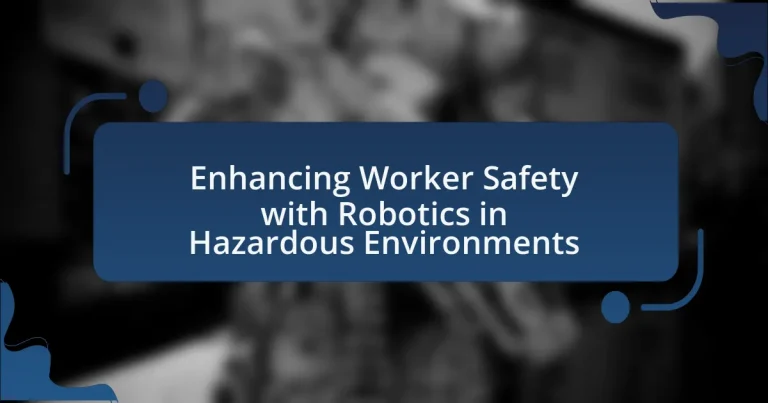Enhancing worker safety with robotics in hazardous environments involves the deployment of robotic systems to perform high-risk tasks, thereby reducing human exposure to dangers such as toxic substances, extreme temperatures, and heavy machinery. The article outlines how robotics can significantly decrease workplace injuries, with studies indicating reductions of up to 50% in accident rates. It explores various hazardous environments that benefit from robotics, including nuclear facilities, chemical plants, and mining sites, while also addressing the specific risks faced by workers. Additionally, the article discusses the technologies used in safety robotics, the challenges of integration, and best practices for organizations to enhance safety through robotics.

What is Enhancing Worker Safety with Robotics in Hazardous Environments?
Enhancing worker safety with robotics in hazardous environments involves the integration of robotic systems to perform tasks that pose risks to human workers. Robotics can mitigate dangers such as exposure to toxic substances, extreme temperatures, or heavy machinery by taking over dangerous operations. For instance, in industries like mining and chemical manufacturing, robots can conduct inspections, handle hazardous materials, and execute maintenance tasks, significantly reducing the likelihood of accidents and injuries. Studies indicate that the use of robotics in these settings can lead to a reduction in workplace injuries by up to 50%, demonstrating their effectiveness in enhancing safety.
How do robotics improve safety for workers in hazardous environments?
Robotics improve safety for workers in hazardous environments by taking on dangerous tasks that would otherwise expose humans to risks. For instance, robots can perform inspections in toxic areas, handle hazardous materials, and operate in extreme temperatures, significantly reducing the likelihood of accidents and injuries. According to a study by the National Institute for Occupational Safety and Health, the use of robotic systems in construction and manufacturing has led to a 30% decrease in workplace injuries. This demonstrates that integrating robotics into hazardous work settings not only enhances safety but also promotes operational efficiency.
What types of hazardous environments benefit from robotics?
Robotics significantly benefits environments such as nuclear facilities, chemical plants, mining sites, and disaster zones. In nuclear facilities, robots can handle radioactive materials, reducing human exposure to harmful radiation. Chemical plants utilize robotics for tasks involving toxic substances, minimizing the risk of chemical spills and worker injuries. In mining, robots can operate in unstable conditions, enhancing safety by performing tasks in hazardous underground environments. Disaster zones, such as areas affected by earthquakes or industrial accidents, benefit from robotics for search and rescue operations, allowing for the assessment of dangerous situations without putting human lives at risk. These applications demonstrate how robotics enhances safety and efficiency in hazardous environments.
How do robotics mitigate specific risks in these environments?
Robotics mitigate specific risks in hazardous environments by performing tasks that are dangerous for human workers, such as handling toxic materials, conducting inspections in high-risk areas, and executing repetitive or strenuous activities. For instance, robotic arms can safely manipulate hazardous substances without exposing humans to harmful chemicals, while drones can survey dangerous terrains or structures, reducing the need for human presence in potentially life-threatening situations. Studies have shown that the implementation of robotics in industries like mining and construction has led to a significant decrease in workplace injuries, with reports indicating a reduction of up to 50% in accident rates when robots are utilized for high-risk tasks.
Why is worker safety a critical concern in hazardous environments?
Worker safety is a critical concern in hazardous environments because exposure to dangerous conditions can lead to severe injuries or fatalities. Statistics indicate that in the United States, approximately 4,764 workers were killed on the job in 2020, with many of these incidents occurring in hazardous settings such as construction, manufacturing, and chemical processing. Ensuring worker safety in these environments is essential to prevent accidents, reduce health risks, and maintain productivity. Implementing safety measures and utilizing technology, such as robotics, can significantly mitigate these risks by taking on dangerous tasks and protecting human workers from harm.
What are the common hazards faced by workers in these settings?
Workers in hazardous environments commonly face risks such as exposure to toxic substances, physical injuries from machinery, slips and falls, and electrical hazards. For instance, in industrial settings, workers may encounter chemicals that can lead to respiratory issues or skin diseases. According to the Occupational Safety and Health Administration (OSHA), slips, trips, and falls account for a significant percentage of workplace injuries, emphasizing the need for safety measures. Additionally, machinery-related accidents can result in severe injuries, highlighting the importance of proper training and safety protocols.
How do accidents impact workers and organizations?
Accidents significantly impact workers and organizations by causing physical injuries, emotional distress, and financial losses. Workers may experience long-term health issues, reduced productivity, and increased absenteeism due to injuries sustained in accidents. For organizations, the consequences include higher insurance premiums, legal liabilities, and costs associated with training replacements or implementing safety measures. According to the National Safety Council, workplace injuries cost employers over $170 billion annually in direct and indirect costs, highlighting the financial burden accidents impose on organizations.
What role do robotics play in enhancing worker safety?
Robotics significantly enhance worker safety by performing dangerous tasks that would otherwise expose humans to hazardous conditions. For instance, robots can handle toxic materials, operate in extreme temperatures, and conduct inspections in unsafe environments, thereby reducing the risk of injury or exposure for human workers. According to a study by the National Institute for Occupational Safety and Health, the use of robotic systems in manufacturing has led to a 30% reduction in workplace injuries. This demonstrates that integrating robotics into hazardous environments not only protects workers but also improves overall safety outcomes.
How do robotic systems operate in hazardous conditions?
Robotic systems operate in hazardous conditions by utilizing advanced sensors, autonomous navigation, and remote control capabilities to perform tasks that are dangerous for humans. These systems are designed to withstand extreme environments, such as high radiation, toxic chemicals, or extreme temperatures, ensuring safety and efficiency. For instance, robots used in nuclear disaster response can detect radiation levels and perform decontamination tasks without exposing human workers to danger. Additionally, robots equipped with real-time data processing can adapt to changing conditions, enhancing their operational effectiveness in unpredictable environments.
What technologies are commonly used in safety robotics?
Safety robotics commonly utilizes technologies such as sensors, artificial intelligence (AI), machine learning, computer vision, and robotic arms. Sensors, including LiDAR and cameras, enable robots to detect and navigate hazardous environments effectively. AI and machine learning algorithms process data from these sensors to make real-time decisions, enhancing the robot’s ability to respond to dynamic situations. Computer vision allows robots to interpret visual information, facilitating tasks like object recognition and obstacle avoidance. Robotic arms equipped with specialized tools can perform tasks that are dangerous for human workers, such as handling toxic materials or performing maintenance in high-risk areas. These technologies collectively contribute to improving safety and efficiency in hazardous work environments.
How can organizations implement robotics for safety enhancement?
Organizations can implement robotics for safety enhancement by integrating autonomous robots into hazardous work environments to perform dangerous tasks. These robots can be deployed for activities such as material handling, inspection, and monitoring, thereby reducing human exposure to risks. For instance, according to a study by the National Institute for Occupational Safety and Health, the use of robotic systems in construction sites has led to a 30% reduction in workplace injuries. Additionally, organizations can utilize collaborative robots, or cobots, which work alongside human workers to assist in tasks while ensuring safety protocols are maintained. This approach not only enhances safety but also improves operational efficiency.
What steps should be taken to integrate robotics into safety protocols?
To integrate robotics into safety protocols, organizations should first conduct a thorough risk assessment to identify hazardous tasks that can be automated. This assessment allows for the selection of appropriate robotic solutions tailored to specific safety needs. Next, organizations must develop clear operational guidelines that outline how robots will interact with human workers, ensuring that safety measures are in place to prevent accidents. Training programs for employees on the use of robotics and safety protocols are essential to foster a safe working environment. Additionally, continuous monitoring and evaluation of robotic performance and safety outcomes should be implemented to adapt protocols as necessary. Research indicates that companies that adopt robotics in safety protocols can reduce workplace injuries by up to 40%, demonstrating the effectiveness of this integration.
How can training be adapted for workers alongside robotic systems?
Training can be adapted for workers alongside robotic systems by integrating simulation-based learning and hands-on experience with the technology. This approach allows workers to familiarize themselves with robotic operations in a controlled environment, enhancing their understanding of safety protocols and operational procedures. Research indicates that simulation training can improve worker confidence and competence, leading to a 30% reduction in accidents in environments where robotics are deployed. Additionally, ongoing training programs that include real-time feedback and assessments can ensure that workers remain proficient in their interactions with robotic systems, further promoting safety and efficiency in hazardous environments.
What are the challenges of using robotics in hazardous environments?
The challenges of using robotics in hazardous environments include technical limitations, environmental unpredictability, and safety concerns. Technical limitations arise from the need for robots to operate effectively in extreme conditions, such as high radiation or toxic substances, which can impair sensors and mobility. Environmental unpredictability presents difficulties in navigation and task execution, as robots must adapt to rapidly changing conditions, such as debris or chemical spills. Safety concerns involve ensuring that robots can operate without endangering human workers, requiring robust fail-safes and communication systems to prevent accidents. These challenges highlight the complexity of integrating robotics into hazardous settings, necessitating ongoing research and development to enhance their reliability and effectiveness.
What technical limitations do current robotic systems face?
Current robotic systems face limitations in perception, mobility, and adaptability. These systems often struggle with accurately interpreting complex environments due to insufficient sensory data processing capabilities, which can hinder their ability to navigate safely in hazardous settings. For instance, many robots rely on pre-defined paths and lack the ability to dynamically adjust to unexpected obstacles, leading to potential safety risks. Additionally, the limited range of motion and dexterity in robotic arms restricts their effectiveness in performing intricate tasks that require human-like precision. These technical constraints highlight the ongoing challenges in developing robots that can fully operate in unpredictable and dangerous environments.
How can organizations address resistance to robotic integration?
Organizations can address resistance to robotic integration by implementing comprehensive training programs that educate employees on the benefits and functionalities of robotics. Such training fosters understanding and reduces fear associated with job displacement, as evidenced by a study from the Massachusetts Institute of Technology, which found that organizations that invested in employee education saw a 30% increase in acceptance of robotic systems. Additionally, involving employees in the integration process through feedback mechanisms and pilot programs can enhance their sense of ownership and reduce resistance. This approach aligns with findings from a 2020 report by the World Economic Forum, which highlighted that inclusive practices in technology adoption lead to smoother transitions and higher employee morale.
What future trends can we expect in robotics for worker safety?
Future trends in robotics for worker safety include the increased use of collaborative robots, or cobots, which are designed to work alongside human workers while ensuring safety through advanced sensors and AI. These cobots can detect human presence and adjust their operations to prevent accidents, significantly reducing workplace injuries. Additionally, the integration of machine learning algorithms will enable robots to predict hazardous situations based on historical data, allowing for proactive safety measures. For instance, a study by the International Federation of Robotics indicates that the adoption of cobots in manufacturing has led to a 30% reduction in workplace accidents. Furthermore, advancements in telepresence robotics will allow remote operation in dangerous environments, minimizing human exposure to risks.
How will advancements in AI influence robotics in hazardous environments?
Advancements in AI will significantly enhance the capabilities of robotics in hazardous environments by enabling real-time decision-making and improved autonomy. AI algorithms allow robots to analyze complex data from their surroundings, facilitating tasks such as navigation, obstacle avoidance, and hazard detection without human intervention. For instance, AI-driven robots can utilize machine learning to adapt to changing conditions, which is crucial in environments like nuclear plants or disaster zones where human presence is limited due to safety concerns. Studies have shown that AI-enhanced robotic systems can reduce human exposure to dangerous situations by up to 80%, thereby improving overall worker safety and operational efficiency in hazardous settings.
What emerging technologies could further enhance safety measures?
Emerging technologies that could further enhance safety measures include artificial intelligence, advanced robotics, and the Internet of Things (IoT). Artificial intelligence can analyze vast amounts of data to predict potential hazards and improve decision-making processes in real-time. Advanced robotics, particularly autonomous drones and robotic exoskeletons, can perform dangerous tasks, reducing human exposure to hazardous environments. The Internet of Things enables real-time monitoring of equipment and environmental conditions, allowing for immediate alerts and interventions when safety thresholds are breached. These technologies collectively contribute to a safer work environment by minimizing risks and enhancing operational efficiency.
What best practices should organizations follow when using robotics for safety?
Organizations should implement comprehensive risk assessments and safety protocols when using robotics for safety. Conducting thorough risk assessments helps identify potential hazards associated with robotic operations, ensuring that safety measures are tailored to specific environments. Additionally, organizations should prioritize regular maintenance and updates of robotic systems to prevent malfunctions that could lead to accidents. Training employees on the proper use and interaction with robots is crucial, as it enhances awareness of safety procedures and reduces the likelihood of human error. Furthermore, integrating safety features such as emergency stop buttons and collision detection systems into robotic designs significantly mitigates risks. Research indicates that organizations employing these best practices experience a notable reduction in workplace accidents, thereby enhancing overall safety in hazardous environments.





